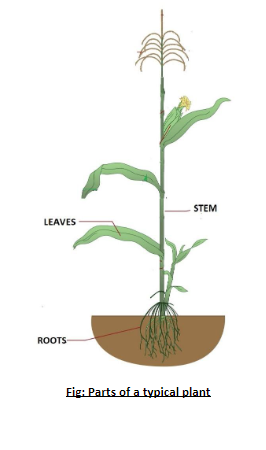
Draw the figure of a plant to show the parts, namely the root, stem and leaves in it.
Answer
555.3k+ views
Hint: Plants are non-motile living organisms, primarily photosynthetic in nature. Generally, plants are green in colour. They belong to the producer level of the ecosystem and are capable of making their own food by the process of photosynthesis. The plant body is divided into several parts with specific functions.
Complete answer:
Plants are living organisms that belong to kingdom Plantae. They are found on land and in water. Plants are capable of converting light energy to chemical energy to make carbohydrates and are known as autotrophs. Most plants contain a green pigment called chlorophyll that helps them to trap light energy from the sun.
The plant body is divided into root, stem, leaves.
The root of a plant is the part that grows under the soil. It is positively geotropic and negatively phototropic. The roots of a plant help the plant to anchor in soil, absorb water and nutrients and form growth regulators.
The stem is the part of the plant found above the soil. The young stems are usually green in colour, while older ones are brown. The stem serves to bear the flowers, fruits and leaves of the plant. It also helps to store the food prepared by the plant and in transport of water and minerals.
Leaves arise from nodes on the stem. It is usually green in colour due to the presence of chlorophyll. The main functions of the leaf is to help in photosynthesis, removal of excess water by transpiration and also reproduction in some plants like Bryophyllum.
The typical parts of a plant are shown in the diagram below:

Note: Plants are living organisms that can make their own food. They are autotrophs. Plants prepare their food by the process of photosynthesis using light from the sun, water from roots and carbon dioxide from air in presence of chlorophyll in the leaves. The process releases oxygen which in turn aids respiration of animals. Plants are very important to the survival of life on earth.
Complete answer:
Plants are living organisms that belong to kingdom Plantae. They are found on land and in water. Plants are capable of converting light energy to chemical energy to make carbohydrates and are known as autotrophs. Most plants contain a green pigment called chlorophyll that helps them to trap light energy from the sun.
The plant body is divided into root, stem, leaves.
The root of a plant is the part that grows under the soil. It is positively geotropic and negatively phototropic. The roots of a plant help the plant to anchor in soil, absorb water and nutrients and form growth regulators.
The stem is the part of the plant found above the soil. The young stems are usually green in colour, while older ones are brown. The stem serves to bear the flowers, fruits and leaves of the plant. It also helps to store the food prepared by the plant and in transport of water and minerals.
Leaves arise from nodes on the stem. It is usually green in colour due to the presence of chlorophyll. The main functions of the leaf is to help in photosynthesis, removal of excess water by transpiration and also reproduction in some plants like Bryophyllum.
The typical parts of a plant are shown in the diagram below:

Note: Plants are living organisms that can make their own food. They are autotrophs. Plants prepare their food by the process of photosynthesis using light from the sun, water from roots and carbon dioxide from air in presence of chlorophyll in the leaves. The process releases oxygen which in turn aids respiration of animals. Plants are very important to the survival of life on earth.
Recently Updated Pages
Master Class 11 Social Science: Engaging Questions & Answers for Success

Master Class 11 Physics: Engaging Questions & Answers for Success

Master Class 11 Maths: Engaging Questions & Answers for Success

Master Class 11 Economics: Engaging Questions & Answers for Success

Master Class 11 Computer Science: Engaging Questions & Answers for Success

Master Class 11 Chemistry: Engaging Questions & Answers for Success

Trending doubts
What is meant by exothermic and endothermic reactions class 11 chemistry CBSE

10 examples of friction in our daily life

One Metric ton is equal to kg A 10000 B 1000 C 100 class 11 physics CBSE

1 Quintal is equal to a 110 kg b 10 kg c 100kg d 1000 class 11 physics CBSE

Difference Between Prokaryotic Cells and Eukaryotic Cells

The camels hump is made of which tissues a Skeletal class 11 biology CBSE




